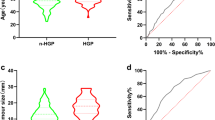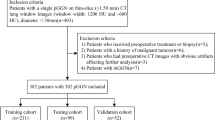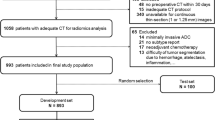Abstract
Objectives
This study aimed to develop and validate a predicting model for the histologic classification of solid lung lesions based on preoperative contrast-enhanced CT.
Methods
A primary dataset of 1012 patients from Tianjin Medical University Cancer Institute and Hospital (TMUCIH) was randomly divided into a development cohort (708) and an internal validation cohort (304). Patients from the Second Hospital of Shanxi Medical University (SHSMU) were set as an external validation cohort (212). Two clinical factors (age, gender) and twenty-one characteristics on contrast-enhanced CT were used to construct a multinomial multivariable logistic regression model for the classification of seven common histologic types of solid lung lesions. The area under the receiver operating characteristic curve was used to assess the diagnostic performance of the model in the development and validation cohorts, separately.
Results
Multivariable analysis showed that two clinical factors and twenty-one characteristics on contrast-enhanced CT were predictive in lung lesion histologic classification. The mean AUC of the proposed model for histologic classification was 0.95, 0.94, and 0.92 in the development, internal validation, and external validation cohort, respectively. When determining the malignancy of lung lesions based on histologic types, the mean AUC of the model was 0.88, 0.86, and 0.90 in three cohorts.
Conclusions
We demonstrated that by utilizing both clinical and CT characteristics on contrast-enhanced CT images, the proposed model could not only effectively stratify histologic types of solid lung lesions, but also enabled accurate assessment of lung lesion malignancy. Such a model has the potential to avoid unnecessary surgery for patients and to guide clinical decision-making for preoperative treatment.
Key Points
• Clinical and CT characteristics on contrast-enhanced CT could be used to differentiate histologic types of solid lung lesions.
• Predicting models using preoperative contrast-enhanced CT could accurately assessment of tumor malignancy based on predicted histologic types.


Similar content being viewed by others
Data Availability
The datasets generated during and/or analysed during the current study are not publicly available due to privacy but are available from the corresponding author on reasonable request.
Abbreviations
- AUC:
-
Area under the curve
- CT:
-
Computed tomography
- HU :
-
Hounsfield Unit
- IQR :
-
Inter-quartile range
- NPV :
-
Negative predictive values
- PPD:
-
Purified protein derivative
- PPV:
-
Positive predictive values
- SD :
-
Standard deviation
- SHSMU:
-
Second Hospital of Shanxi Medical University
- TMUCIH:
-
Tianjin Medical University Cancer Institute and Hospital
- VA:
-
Veterans Affairs
References
Martín-Sánchez JC, Lunet N, González-Marrón A et al (2018) Projections in breast and lung cancer mortality among women: a Bayesian analysis of 52 countries worldwide. Can Res 78:4436–4442
Chen W, Zheng R, Baade PD et al (2016) Cancer statistics in China, 2015. CA Cancer J Clin 66:115–132
Blandin Knight S, Crosbie PA, Balata H, Chudziak J, Hussell T, Dive C (2017) Progress and prospects of early detection in lung cancer. Open Biol 7:170070
Team NLSTR (2011) Reduced lung-cancer mortality with low-dose computed tomographic screening. N Engl J Med 365:395–409
Montaudon M, Latrabe V, Pariente A, Corneloup O, Begueret H, Laurent F (2004) Factors influencing accuracy of CT-guided percutaneous biopsies of pulmonary lesions. Eur Radiol 14:1234–1240
Ozeki N, Iwano S, Taniguchi T et al (2014) Therapeutic surgery without a definitive diagnosis can be an option in selected patients with suspected lung cancer. Interact Cardiovasc Thorac Surg 19:830–837
Merritt RE, Shrager JB (2012) Indications for surgery in patients with localized pulmonary infection. Thorac Cardiovasc Surg 22:325–332
Cui X, Han D, Heuvelmans MA et al (2020) Clinical characteristics and work-up of small to intermediate-sized pulmonary nodules in a Chinese dedicated cancer hospital. Cancer Biol Med 17:199
Li L, Liu Z, Huang H, Lin M, Luo D (2019) Evaluating the performance of a deep learning-based computer-aided diagnosis (DL-CAD) system for detecting and characterizing lung nodules: comparison with the performance of double reading by radiologists. Thorac Cancer 10:183–192
Cui X, Heuvelmans MA, Han D et al (2019) Comparison of Veterans Affairs, Mayo, Brock classification models and radiologist diagnosis for classifying the malignancy of pulmonary nodules in Chinese clinical population. Transl Lung Cancer Res 8:605
Wataya T, Yanagawa M, Tsubamoto M et al (2023) Radiologists with and without deep learning–based computer-aided diagnosis: comparison of performance and interobserver agreement for characterizing and diagnosing pulmonary nodules/masses. Eur Radiol 33(1):348–359
van Riel SJ, Jacobs C, Scholten ET et al (2019) Observer variability for Lung-RADS categorisation of lung cancer screening CTs: impact on patient management. Eur Radiol 29:924–931
Gould MK, Ananth L, Barnett PG (2007) A clinical model to estimate the pretest probability of lung cancer in patients with solitary pulmonary nodules. Chest 131:383–388
Swensen SJ, Silverstein MD, Ilstrup DM, Schleck CD, Edell ES (1997) The probability of malignancy in solitary pulmonary nodules. Application to small radiologically indeterminate nodules. Arch Intern Med 157:849–855
McWilliams A, Tammemagi MC, Mayo JR et al (2013) Probability of cancer in pulmonary nodules detected on first screening CT. N Engl J Med 369:910–919
Susam S, Çinkooğlu A, Ceylan KC et al (2022) Comparison of Brock University, Mayo Clinic and Herder models for pretest probability of cancer in solid pulmonary nodules. Clin Respir J 16:740–749
Hammer MM, Nachiappan AC, Barbosa EJM Jr (2018) Limited utility of pulmonary nodule risk calculators for managing large nodules. Curr Probl Diagn Radiol 47(1):23–27
Tanner NT, Porter A, Gould MK, Li X-J, Vachani A, Silvestri GA (2017) Physician assessment of pretest probability of malignancy and adherence with guidelines for pulmonary nodule evaluation. Chest 152:263–270
Cui X, Heuvelmans MA, Fan S et al (2020) A subsolid nodules imaging reporting system (SSN-IRS) for classifying 3 subtypes of pulmonary adenocarcinoma. Clin Lung Cancer 21(314–325):e314
Wang L, Shen W, Xi Y, Liu S, Zheng D, Jin C (2018) Nomogram for predicting the risk of invasive pulmonary adenocarcinoma for pure ground-glass nodules. Ann Thorac Surg 105:1058–1064
Travis WD, Brambilla E, Nicholson AG et al (2015) The 2015 World Health Organization classification of lung tumors: impact of genetic, clinical and radiologic advances since the 2004 classification. J Thorac Oncol 10:1243–1260
Weir-McCall JR, Joyce S, Clegg A et al (2020) Dynamic contrast–enhanced computed tomography for the diagnosis of solitary pulmonary nodules: a systematic review and meta-analysis. Eur Radiol 30:3310–3323
(2019) Lung CT Screening Reporting & Data System (Lung-RADS). https://www.acr.org/Clinical-Resources/Reporting-and-Data-Systems/Lung-Rads. Available via https://www.acr.org/Clinical-Resources/Reporting-and-Data-Systems/Lung-Rads
Chen Z, Zhang R, Xu F et al (2018) Novel prehospital prediction model of large vessel occlusion using artificial neural network. Front Aging Neurosci 10:181
Cooper W, Bubendorf L, Kadota K et al (2021) WHO Classification of Tumours Thoracic Tumours. IARC: Lyon, France
McLaren CE, Chen W-P, Nie K et al (2009) Prediction of malignant breast lesions from MRI features: a comparison of artificial neural network and logistic regression techniques. Acad Radiol 16:842–851
Herder GJ, Van Tinteren H, Golding RP et al (2005) Clinical prediction model to characterize pulmonary nodules: validation and added value of 18 F-fluorodeoxyglucose positron emission tomography. Chest 128:2490–2496
Zhang X, Yan H-H, Lin J-T et al (2014) Comparison of three mathematical prediction models in patients with a solitary pulmonary nodule. Chin J Cancer Res 26:647
Yang B, Jhun BW, Shin SH et al (2018) Comparison of four models predicting the malignancy of pulmonary nodules: a single-center study of Korean adults. PLoS One 13:e0201242
Han Y, Ma Y, Wu Z et al (2021) Histologic subtype classification of non-small cell lung cancer using PET/CT images. Eur J Nucl Med Mol Imaging 48:350–360
Du D, Gu J, Chen X et al (2021) Integration of PET/CT radiomics and semantic features for differentiation between active pulmonary tuberculosis and lung cancer. Mol Imag Biol 23:287–298
Liu C, Ma C, Duan J et al (2020) Using CT texture analysis to differentiate between peripheral lung cancer and pulmonary inflammatory pseudotumor. BMC Med Imaging 20:1–10
Luo C, Song Y, Liu Y et al (2022) Analysis of the value of enhanced CT combined with texture analysis in the differential diagnosis of pulmonary sclerosing pneumocytoma and atypical peripheral lung cancer: a feasibility study. BMC Med Imaging 22:16
Doyle DJ, Khalili K, Guindi M, Atri M (2007) Imaging features of sclerosed hemangioma. AJR Am J Roentgenol 189:67–72
MacMahon H, Naidich DP, Goo JM et al (2017) Guidelines for management of incidental pulmonary nodules detected on CT images: from the Fleischner Society 2017. Radiology 284:228–243
Liu C, Ma C, Duan J et al (2020) Using CT texture analysis to differentiate between peripheral lung cancer and pulmonary inflammatory pseudotumor. BMC Med Imaging 20:75
Acknowledgements
I wish to devote this paper to my newly born daughter Cui Can, who illuminates my world.
Funding
This work was supported by the Chinese National Key Research and Development Project (Grant No. 2021YFC2500400 and Grant No.2021YFC2500402), Tianjin Key Medical Discipline(Specialty) Construction Project (TJYXZDXK-009A).
Author information
Authors and Affiliations
Corresponding author
Ethics declarations
Guarantor
The scientific guarantor of this publication is Dr. Zhaoxiang Ye.
Conflict of interest
The authors of this manuscript declare no relationships with any companies whose products or services may be related to the subject matter of the article.
Statistics and biometry
One of the authors (Jing Wang) has significant statistical expertise.
Informed consent
Written informed consent was waived by the Institutional Review Board.
Ethical approval
The institutional ethics committee board of Tianjin Medical University Cancer Institute & Hospital approved this study (No. bc2021327).
Methodology
• retrospective
• diagnostic study
• multicenter study
Additional information
Publisher's note
Springer Nature remains neutral with regard to jurisdictional claims in published maps and institutional affiliations.
Supplementary Information
Below is the link to the electronic supplementary material.
Rights and permissions
Springer Nature or its licensor (e.g. a society or other partner) holds exclusive rights to this article under a publishing agreement with the author(s) or other rightsholder(s); author self-archiving of the accepted manuscript version of this article is solely governed by the terms of such publishing agreement and applicable law.
About this article
Cite this article
Cui, X., Zheng, S., Zhang, W. et al. Prediction of histologic types in solid lung lesions using preoperative contrast-enhanced CT. Eur Radiol 33, 4734–4745 (2023). https://doi.org/10.1007/s00330-023-09432-3
Received:
Revised:
Accepted:
Published:
Issue Date:
DOI: https://doi.org/10.1007/s00330-023-09432-3




